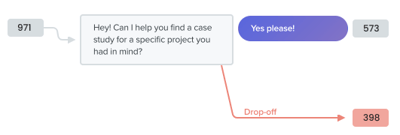


7 Changes That Make a Big Difference To Your Conversational Marketing




A small change to your conversational marketing strategy can have a big impact.
Try changing up your approach, and experiment with different methods until you find what works best for you and your team. Remember that even the smallest change can make a big difference, so don't be afraid to experiment.
Here are a few small changes you can implement to get started:
Greet visitors with an interesting message
At Six & Flow, our culture and brand voice is playful. So, we bring that into our chatbot strategy. Sometimes the best way to capture somebody's attention is to ask something interesting.
Try this - On your home page, rather than adding a general "hello" message, add a little spice. Bring some humour to your chatbot. When you pair chatbot scripts with AI tools, your bot can become quite sophisticated, and humorous at times too.

Review Drop-Off points
This may seem like a no-brainer, but it's best practice to review drop-off points. Your conversational marketing strategy may include some complex workflows, that are personalised and segmented. If a playbook isn't seeing the results you need, even some small tweaks discovered at a drop-off point could make all the difference.

Connect Drift with your CRM
If you're not already using Drift to connect with your CRM, you're missing out on a valuable opportunity. By connecting Drift with your CRM, you can ensure that all conversations are being tracked and stored in one place. This offers your customer service and marketing teams a complete picture of the user's journey from visitor to customer.
Provide after-hours support
Your website doesn't have to be a 24/hour support centre, but your chatbot can be. If you're using a live chat tool like Drift, you can set up your bot to automatically take over when your team is unavailable.
This way, you can provide valuable support outside of normal business hours, and ensure that your customers always have a positive experience with your brand - even when they're trying to reach you outside of office hours.

Add emojis
We love emojis! And it turns out, our customers do too.
In fact, emojis can be really useful in chatbot conversations. They help to add personality and tone to your messages and can make complex topics a little easier to understand.
End conversations asking visitors to subscribe to a newsletter
Just because one conversation is over doesn't mean you have to stop staying in touch.
Asking visitors to subscribe to a newsletter or follow your brand on social media is a great way to keep the conversation going - and ensure that you're always top of mind.
Not every conversation should try and capture an email address
Sometimes, the goal is to just keep a visitor on your site. To help them continue self-serving themselves.
If that's the case, don't try and force a sign-up or subscription.
We wrote a blog post saying how the wrong call to action can make or break a sale. The same goes for conversational marketing. It's best to create chatbot flows that understand where a user is in your journey and continue sharing content that helps them move along your funnel.
A note about Conversational Marketing and Inbound Marketing
When combined with inbound marketing, conversational marketing becomes even more powerful.
Inbound marketing is all about attracting strangers and converting them into leads and customers through helpful content. A well-defined chatbot strategy helps nurture leads across your website, and in turn, your funnel.
By pairing these two powerful marketing strategies, businesses can reap the benefits of both increased sales and long-term customer loyalty.








